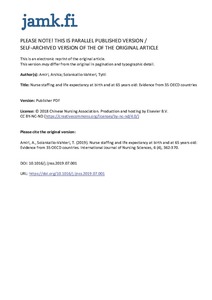Nurse staffing and life expectancy at birth and at 65 years old : evidence from 35 OECD countries
Amiri, Arshia; Solankallio-Vahteri, Tytti (2019)
Amiri, Arshia
Solankallio-Vahteri, Tytti
Elsevier (Singapore)
2019
Julkaisun pysyvä osoite on
https://urn.fi/URN:NBN:fi-fe2019111838517
https://urn.fi/URN:NBN:fi-fe2019111838517
Tiivistelmä
Objective
To measure the possible magnitude of the role nurse staffing has on increasing life expectancy at birth and at 65 years old.
Methods
The statistical technique of panel data analysis was applied to investigate the relationship from the number of practicing nurses’ density per 1000 population to life expectancy at birth and at 65 years old. Five control variables were used as the proxies for the levels of medical staffing, health care financial and physical resources, and medical technology. The observations of 35 member countries of Organization for Economic Co-operation and Development (OECD) were collected from OECD Health Statistics over 2000–2016 period.
Results
There were meaningful relationships from nurse staffing to life expectancy at birth and at 65 years with the long-run elasticities of 0.02 and 0.08, respectively. Overall, the role of nursing characteristics in increasing life expectancy indicators varied among different health care systems of OECD countries and in average were determined at the highest level in Japan (0.25), followed by Iceland (0.24), Belgium (0.21), Czech Republic (0.21), Slovenia (0.20) and Sweden (0.18).
Conclusion
A higher proportion of nursing staff is associated with higher life expectancy in OECD countries and the dependency of life expectancy to nursing staff would increase by aging. Hence, the findings of this study warn health policy makers about ignoring the effects nursing shortages create e.g. increasing the risk of actual age-specific mortality, especially in care of elderly people.
To measure the possible magnitude of the role nurse staffing has on increasing life expectancy at birth and at 65 years old.
Methods
The statistical technique of panel data analysis was applied to investigate the relationship from the number of practicing nurses’ density per 1000 population to life expectancy at birth and at 65 years old. Five control variables were used as the proxies for the levels of medical staffing, health care financial and physical resources, and medical technology. The observations of 35 member countries of Organization for Economic Co-operation and Development (OECD) were collected from OECD Health Statistics over 2000–2016 period.
Results
There were meaningful relationships from nurse staffing to life expectancy at birth and at 65 years with the long-run elasticities of 0.02 and 0.08, respectively. Overall, the role of nursing characteristics in increasing life expectancy indicators varied among different health care systems of OECD countries and in average were determined at the highest level in Japan (0.25), followed by Iceland (0.24), Belgium (0.21), Czech Republic (0.21), Slovenia (0.20) and Sweden (0.18).
Conclusion
A higher proportion of nursing staff is associated with higher life expectancy in OECD countries and the dependency of life expectancy to nursing staff would increase by aging. Hence, the findings of this study warn health policy makers about ignoring the effects nursing shortages create e.g. increasing the risk of actual age-specific mortality, especially in care of elderly people.
